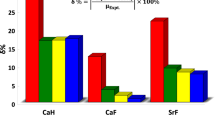Abstract
The torsional potentials, molecular structures, conformational stability, and vibrational wavenumbers for the rotational isomers of 2-formylfuran and 3-formylfuran are computed using the density functional theory (B3LYP) method with the 6-31+G* basis set. All structures are fully optimized and the optimized geometries, rotational constants, dipole moments, and energies are presented. From the computations, both 2-formylfuran and 3-formylfuran are predicted to exist predominantly in trans conformation with a cis–trans rotational barrier of 11.19 kcal/mol and 8.10 kcal/mol, respectively. The vibrational wavenumbers and the corresponding vibrational assignments of the molecules in the C s symmetry are examined and the infrared spectra of the molecules are simulated using the wavenumbers and the corresponding intensities obtained from the computations. The effect of solvents on the conformational stability of all the molecules in nine different solvents (heptane, chloroform, tetrahydrofuran, dichloroethane, acetone, ethanol, methanol, dimethylsulfoxide, and water) is investigated. The integral equation formalism in the polarizable continuum model (IEF-PCM) is used for all solution phase computations.
Similar content being viewed by others
References
G. Allen and H. J. Bernstein, Can. J. Chem., 33, 1055–1061 (1955).
G. J. Karabatsos and F. M. Vane, J. Am. Chem. Soc., 85, 3886–3888 (1963).
T. S. Little, J. Qiu, and J. R. Durig, Spectrochim. Acta A, 45, 789–794 (1989).
F. A. Miller, W. G. Fateley, and R. E. Witkowski, Spectrochim. Acta A, 23, 891–908 (1967).
J. Banki, F. Billes, M. Gal, A. Grofcsik, G. Jalsovsky, and L. Sztraka, J. Mol. Struct., 142, 351–354 (1986).
C. L. Chen and G. L. D. Ritchie, J. Chem. Soc., Perkin Trans. 2, 10, 1461–1465 (1973).
K. K. Baldridge, V. Jonas, and A. D. Bain, J. Chem. Phys., 113, 7519–7529 (2000).
T. Ilieus, M. Bolboaca, R. Pacurariu, D. Maniu, and W. Kiefer, J. Raman Spectrosc., 34, 705–710 (2003).
M. Rogojerov, G. Keresztury, and B. Jordanov, Spectrochim. Acta A, 61, 1661–1670 (2005).
R. A. Motiyenko, E. A. Alelseev, S. F. Dyubko, and F. J. Lovas, J. Mol. Spectrosc., 240, 93–101 (2006).
A. Bain and D. P. Hazendonk, J. Phys. Chem. A, 101, 7182–7188 (1997).
R. Rivelinor, K. Coutinho, and S. Canuto, J. Phys. Chem. B, 106, 12317–12322 (2002).
H. Ashish and P. Ramasami, Mol. Phys., 106, 175–185 (2008).
I. G. John, G. L. D. Ritchie, and L. Radom, J. Chem. Soc., Perkin Trans. 2, 12, 1601–1607 (1977).
L. Lunazzi and G. Placucci, Tetrahedron, 32, 6427–6434 (1991).
M. J. Frisch et al, Gaussian 03, Gaussian Inc., Pittsburgh, PA (2003).
A. D. Becke, J. Chem. Phys., 98, 5648–5653 (1993).
C. Lee, W. Yang, and R. G. Parr, Phys. Rev. B, 37, 785–789 (1988).
E. Cancès, B. Mennucci, and J. Tomasi, J. Chem. Phys., 107, 3032–3041 (1997).
B. Mennucci and J. Tomasi, J. Chem. Phys., 106, 5151–5158 (1997).
J. Tomasi, B. Mennucci, and E. Cancès, J. Mol. Struct.: THEOCHEM, 464, 211–226 (1999).
Y. J. Umar, J. Mol. Struct.: THEOCHEM, 728, 111–115 (2005).
Y. Umar, T. Jimoh, and M. A. Morsy, J. Mol. Struct.: THEOCHEM, 725, 157–161 (2005).
Y. Umar, Spectrochim. Acta A, 64, 568–573 (2006).
Y. Umar, Spectrochim. Acta A, 71, 1907–1913 (2009).
R. Dennington II, T. Keith, J. Millam, et al., GaussView, Version 3.09, Semichem Inc., Shawnee Mission, KS (2003).
Author information
Authors and Affiliations
Corresponding author
Additional information
Original Russian Text © 2015 Y. Umar, J. Tijani.
The text was submitted by the authors in English. Zhurnal Strukturnoi Khimii, Vol. 56, No. 7, pp. 1369-1376, November-December, 2015.
Rights and permissions
About this article
Cite this article
Umar, Y., Tijani, J. Density functional theory study of the rotational barriers, conformational preference, and vibrational spectra of 2-formylfuran and 3-formylfuran. J Struct Chem 56, 1305–1312 (2015). https://doi.org/10.1134/S0022476615070112
Received:
Published:
Issue Date:
DOI: https://doi.org/10.1134/S0022476615070112




